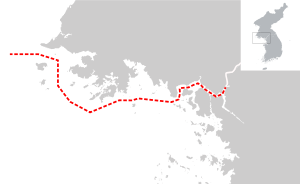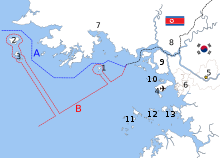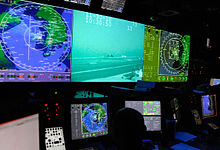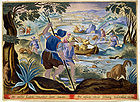- Korean maritime border incidents
-
Korean maritime border incidents Part of Division of Korea 
Incidents have occurred in waters south of the Northern Limit Line, shown in red separating North and South Korea.Date 1999 – Present Location Northern Limit Line, Yellow Sea Result Conflict ongoing Belligerents  Democratic People's Republic of Korea
Democratic People's Republic of Korea Republic of Korea
Republic of KoreaCasualties and losses As of November 2010:
53 killed
95 wounded
1 torpedo boat sunk
1 gunboat damaged
6 patrol boats damagedAs of November 2010:
54 killed
99 wounded
1 corvette sunk
1 patrol boat sunk
1 corvette damaged
2 patrol boats damagedAs of November 2010:
2 South Korean civilians killed
3 South Korean civilians woundedKorean maritime border incidentsFirst Battle of Yeonpyeong - Second Battle of Yeonpyeong - Battle of Daecheong - ROKS Cheonan sinking - Shelling of YeonpyeongKorean maritime border incidents are a series of military clashes between North Korea and South Korea in the Yellow Sea (aka West Sea (서해)) off the west coast of the Korean peninsula. The clashes have occurred after the Korean War Armistice Agreement which did not resolve the nature of the maritime boundary in the West Sea. They have been aggravated by the presence of a rich fishing ground which is valued by both countries.
Contents
History
In 1953 the Korean Armistice Agreement ending the Korean War and establishing the Military Demarcation Line on land made no provision for the boundary between North and South in the Western Sea. In this area a number of islands, belonging to South Korea, lay off the Ongjin Peninsula, now occupied by North Korea.
After the United Nations Command and North Korea failed to reach an agreement, the Northern Limit Line was unilaterally set by the U.S.-led United Nations military forces on August 30, 1953. The line was originally drawn, when North Korea had no significant naval forces, as a practical operational control measure to prevent southern incursions into the north. However, its role has since transformed to prevent North Korean ships heading south.[1][2] This line identified the northern ambit of the area patrolled by UN forces in the Yellow Sea. It is unclear when North Korea was informed of the existence of the NLL. Many sources suggest this was done promptly, but in a now declassified 1973 joint diplomatic cable, the U.S. Department of State and Department of Defense stated that "We are aware of no evidence that NLL has ever been officially presented to North Korea."[3][4]
In 1973, the status of the NLL was challenged by the DPRK negotiators at the 346th meeting of the Military Armistice Commission.[5] At that time North Korea sent its patrol ships south of the NLL approximately 43 times in October and November 1973.[6]
In 1999, the words of negotiators were matched with more assertive actions as DPRK vessels began challenging the NLL, although there was no dispute that a few small islands close to the North Korean coastline remained within the jurisdiction of the United Nations Command since 1953.[2]
In 1999, the DPRK unilaterally asserted a maritime Military Demilitarization Line which was configured in waters to the south of the NLL. The dissimilar maritime boundary lines became the foundation of the overlapping territorial claims of the two Koreas.[7]
Since 1999, DPRK fishing and naval vessels have regularly ventured across the NLL. In many cases the North Korean vessels return north of the NLL when challenged by the South Korean military, however in some cases there have been collisions between vessels and exchanges of fire have occurred. As the waters along the NLL are rich in Blue crab, the seaborne clashes have sometimes been dubbed "crab wars".[8] Serious naval battles have taken place between North Korean and South Korean vessels in June 1999, June 2002 and November 2009. In March 2010 the Cheonan, a South Korean naval vessel, was sunk by an explosion near Baengnyeong Island. In November 2010 North Korean artillery fired on Yeonpyeong Island.
Chronology
 The disputed maritime border between North and South Korea in the Yellow Sea:[9]
The disputed maritime border between North and South Korea in the Yellow Sea:[9]
A: United Nations Command-created Northern Limit Line, 1953[10]
B: North Korea-declared "Inter-Korean MDL in the Yellow Sea", 1999[11]
The locations of specific islands are reflected in the configuration of each maritime boundary, including
Other map features4-Jung-gu (Incheon Intl. Airport), 5-Seoul, 6-Incheon, 7-Haeju, 8-Kaesong, 9-Ganghwa County, 10-Bukdo Myeon, 11-Deokjeokdo, 12-Jawol Myeon, 13-Yeongheung MyeonThe chronology of serial events is a list of discrete incidents and a cumulative narrative. In the two Koreas, the unfolding story was shaped across the arc of an unfolding history.[12]
The significance of each naval engagements was construed differently in the two Koreas. Details about event were widely disseminated via newspapers, radio, television and the internet.[13]
1999 incident
Main article: First Battle of YeonpyeongOn 15 June 1999, North Korean torpedo boats and two patrol boats crossed into the disputed waters, escorting a group of fishing boats. High-speed South Korean patrol boats approached the vessels, attempting to ram and repel them. The North Koreans then opened fire, which the South Koreans returned.[14]
The battle resulted in the loss of a North Korean torpedo boat, five patrol boats were damaged, 30 sailors killed and 70 wounded. One South Korean patrol craft was lightly damaged along with a corvette.[14] As this was done against the backdrop of high level talks between the Koreas in Beijing, it generated considerable tension. However, neither side escalated, and the talks continued.
The United States and China both expressed concern regarding the clash and both expressed hope of a diplomatic solution. Furthermore, it drew attention to the widening gap in military capabilities between the two Koreas and humiliated the North, which styles itself a military power.[15]
The consequences of this 1999 incident would be revisited by Koreans during the course of subsequent clashes in the Yellow Sea.[12]
2002 incident
Main article: Second Battle of YeonpyeongOn the morning of 29 June 2002, two North Korean (DPRK) patrol boats crossed the NLL near Yeonpyeong island. When approached by two South Korean (ROK) boats, they opened fire, which was returned. After a half-hour exchange, the DPRK boats withdrew to their side of the boundary line; one was seen to be on fire and badly damaged.
One ROK boat was also badly damaged, sinking later whilst under tow back to port. Four ROK sailors were killed, and 18 wounded; DPRK casualties are unknown.
2004 incident
On 1 November 2004 three North Korean vessels crossed the NLL. They were challenged by South Korean patrol boats, but did not respond. The ROK vessels opened fire and the DPRK boats withdrew without returning fire. No casualties were reported.
2009 incident
Main article: Battle of DaecheongOn 10 November 2009, a North Korean gunboat entered South Korean waters off Daecheong Island in the Yellow Sea. The craft was intercepted by a corvette and four patrol boats of the South Korean Navy and a battle began. The North Korean vessel was heavily damaged by South Korean fire and fled back into friendly waters. One South Korean patrol boat was slightly damaged. One North Korean was killed and three others were wounded, the South Koreans sustained no casualties.
2010 incidents
January
On January 27, 2010, North Korea fired artillery shells into the water near the NLL and South Korean vessels returned fire.[16] The incident took place near Baengnyeong Island.[17] Three days later, North Korea continued to fire artillery towards the area.[18]
March
Main article: ROKS Cheonan sinkingOn 26 March 2010, the Cheonan, a South Korean naval vessel, was sunk by an explosion near Baengnyeong Island in the Yellow Sea.
A rescue operation recovered 58 survivors, but 46 sailors were lost.
In May, a South Korean led international investigation group concluded that the sinking of the warship was in fact the result of a North Korean torpedo attack. Included in this multinational group were experts from Australia, Canada, Sweden, the United Kingdom and the United States.[19][20]
In June, North Korea denied involvement.[21]
In July, the United Nations Security Council made a Presidential Statement condemning the attack but without identifying the attacker.[22]
November
Main article: Bombardment of Yeonpyeong USS George Washington monitoring center during a joint US and South Korea military exercise in the Yellow Sea following an artillery exchange at Yeonpyeong Island—November 2010.
USS George Washington monitoring center during a joint US and South Korea military exercise in the Yellow Sea following an artillery exchange at Yeonpyeong Island—November 2010.
On 23 November 2010.[23] following a South Korean artillery exercise on Yeonpyeong Island, North Korean forces fired around 170 artillery shells and rockets at Yeonpyeong.[24] The bombardment caused widespread damage on the island, killing four South Koreans and injuring 19.
South Korea retaliated by shelling North Korean gun positions. As images of the shelling were spread by media and across the internet,[25] the sight of burning houses and plumes of smoke prompted international reaction.[26]
As an immediate response to the increased tensions in the area, the American nuclear-powered aircraft carrier USS George Washington was sent from Japan to demonstrate "the strength of the Republic of Korea-U.S. alliance and [ROK-US] commitment to regional stability through deterrence.".[27]
Notes
- ^ Kotch, John Barry; Abbey, Michael (2003). "Ending naval clashes on the Northern Limit Line and the quest for a West Sea peace regime". Asian Perspective 27 (2): 175–204. http://www.asianperspective.org/articles/v27n2-f.pdf. Retrieved 2010-11-27.
- ^ a b Moo Bong Ryoo (11 March 2009). "The Korean Armistice and the Islands". Strategy research project (U.S. Army War College). http://www.dtic.mil/cgi-bin/GetTRDoc?AD=ADA500904&Location=U2&doc=GetTRDoc.pdf. Retrieved 26 November 2010.
- ^ Daniel Ten Kate and Peter S. Green (December 17, 2010). "Defending Korea Line Seen Contrary to Law by Kissinger Remains U.S. Policy". Bloomberg. http://www.bloomberg.com/news/2010-12-16/defending-korea-line-seen-contrary-to-law-by-kissinger-remains-u-s-policy.html. Retrieved December 18, 2010.
- ^ Kenneth Rush (22 December 1973). "ROKG legal memorandum on northwest coastal incidents". U.S. Department of State. 1973STATE249865. http://aad.archives.gov/aad/createpdf?rid=107420&dt=2472&dl=1345. Retrieved 18 December 2010.
- ^ Elferink, Alex G. Oude. (1994). The Law of Maritime Boundary Delimitation: a Case Study of the Russian Federation, p. 314. at Google Books
- ^ Seong-Geol Hong, Sun-Pyo Kim, Hyung-Ki Lee (2001-06-30). "Fisheries Cooperation and Maritime Delimitation Issues between North Korea and Its Neighboring Countries". Ocean Policy Research (Korea Maritime Institute) 16 (1): pp. 208–209 (PDF 18–19). http://www.kmi.re.kr/data/linksoft/admin/yun_un/up_file/opr161-06.pdf. Retrieved 2010-11-28.
- ^ Ryoo, pp. 13-15 (at PDF-pp. 21-23).
- ^ Glosserman, Brad (June 14, 2003). "Crab wars: Calming the waters in the Yellow Sea". Asia Times. http://www.atimes.com/atimes/Korea/EF14Dg03.html. Retrieved 2010-11-25.
- ^ Ryoo, p. 13 (at PDF-p. 21).
- ^ "Factbox: What is the Korean Northern Limit Line?" Reuters (UK). November 23, 2010; retrieved 26 Nov 2010.
- ^ "NLL—Controversial Sea Border Between S.Korea, DPRK, " People's Daily (PRC), 2002-11-21; retrieved 2010-11-26.
- ^ a b (1999) Kwang-Tae Kim. "North, South Korea clash at sea before Obama visit," Journal News (US). November 10, 2009; published November 2009 image showing unidentified man watching tv re-broadcast of archived footage from 1999 ROK-DPRK naval clash]; (2002) Herskovitz, Jon and Kim Yeon-hee. "2 Koreas in brief naval clash, vessels hit," Canada.com. November 10, 2009; published November 10, 2009 image of unidentified man watching tv re-broadcast of archival footage from 2002 clash at sea; (2009) Kwang-Tae Kim. "North, South Korea clash at sea before Obama visit," Journal News (US). November 10, 2009; published image of 2 unidentified men watching tv broadcast as events unfold on the same day.
- ^ "Breaking news: South Korean ship," KoreAm (IamKorean.com, US). March 26, 2010; published image of woman watching tv broadcast about the sinking of the ROKS Cheonan on the same day the ship was lost; compare Kwang-Tae Kim. "North, South Korea clash at sea before Obama visit," Journal News (US). November 10, 2009; Herskovitz, Jon and Kim Yeon-hee. "2 Koreas in brief naval clash, vessels hit," Canada.com. November 10, 2009.
- ^ a b CNN - Seoul: Engagement to continue despite deadly Korean naval battle - June 15, 1999
- ^ Northern Limit Line (NLL) West Sea Naval Engagements
- ^ North and South Korea exchange fire near sea border. BBC News. January 27, 2010.
- ^ N. Korea fires into western sea border. Yonhap. January 27, 2010.
- ^ Tang, Anne (January 29, 2010). "DPRK fires artillery again near disputed sea border: gov't". Xinhua. http://news.xinhuanet.com/english2010/world/2010-01/29/c_13155902.htm.
- ^ Foster, Peter; Moore, Malcolm (20 May 2010). "North Korea condemned by world powers over torpedo attack". London: Daily Telegraph. http://www.telegraph.co.uk/news/worldnews/asia/northkorea/7743830/North-Korea-condemned-by-world-powers-over-torpedo-attack.html. Retrieved 20 May 2010.
- ^ Park In-kook (4 June 2010), "Letter dated 4 June 2010 from the Permanent Representative of the Republic of Korea to the United Nations addressed to the President of the Security Council", United Nations Security Council, S/2010/281, http://www.securitycouncilreport.org/atf/cf/%7B65BFCF9B-6D27-4E9C-8CD3-CF6E4FF96FF9%7D/DPRK%20S%202010%20281%20SKorea%20Letter%20and%20Cheonan%20Report.pdf, retrieved 11 July 2010
- ^ "Press Conference on Situation in Korean Peninsula: DPRK Permanent Representative to the United Nations Sin Son Ho". Department of Public Information (United Nations). 15 June 2010. http://www.un.org/News/briefings/docs/2010/100615_Cheonan.doc.htm. Retrieved 11 July 2010.
- ^ "Presidential Statement: Attack on Republic of Korea Naval Ship ‘Cheonan’". United Nations Security Council (United Nations). 9 July 2010. S/PRST/2010/13. http://www.un.org/News/Press/docs/2010/sc9975.doc.htm. Retrieved 11 July 2010.
- ^ "Report: N. Korea fires on S. Korea, injuring at least 17". CNN. November 23, 2010. http://www.cnn.com/2010/WORLD/asiapcf/11/23/nkorea.skorea.military.fire/index.html?hpt=T1&iref=BN1. Retrieved November 23, 2010.
- ^ McDonald, Mark (November 23, 2010). "North and South Korea Exchange Fire, Killing Two". The New York Times. http://www.nytimes.com/2010/11/24/world/asia/24korea.html?src=mv. Retrieved November 23, 2010.
- ^ Google search, images of smoke yeonpyeong, about 225,000 results; retrieved 8 Dec 2010
- ^ "Smoke with fire," The Eoncomist (UK). November 23, 2010.
- ^ Kirk, Donald. "USS George Washington heads for Yellow Sea; North Korea's top Kims visit factory," World Tribune. November 24, 2010.
References
- Elferink, Alex G. Oude, (1994). The Law of Maritime Boundary Delimitation: a Case Study of the Russian Federation. Dordrecht: Martinus Nijhoff. 10-ISBN 079233082X/13-ISBN 9780792330820; OCLC 123566768
- Seong-Geol Hong, Sun-Pyo Kim, Hyung-Ki Lee (2001-06-30). "Fisheries Cooperation and Maritime Delimitation Issues between North Korea and Its Neighboring Countries". Ocean Policy Research (Korea Maritime Institute) 16 (1): 191–216. http://www.kmi.re.kr/data/linksoft/admin/yun_un/up_file/opr161-06.pdf. Retrieved 2010-11-28.
Categories:- Military history of Korea
- Territorial disputes of North Korea
- Territorial disputes of South Korea
- North Korea–South Korea border
- Aftermath of the Korean War
- History of fishing
Wikimedia Foundation. 2010.


